#taijisword
Text
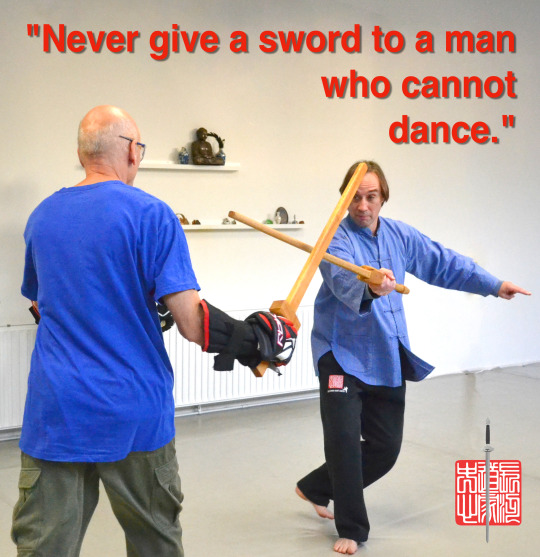
"Never give a sword to a man who cannot dance.” Or at least Confucius is reportedly said so, though this quote is more likely apocryphal than genuine. If he had did indeed written this, Confucius would have no doubt have been using it as a metaphor for not placing someone in a position they are not qualified to fill. If we take this idea literally, then Confucius probably would have actually meant dancing when asked whether or not to trust someone with a Jiàn. Though probably not the sort of dancing you are thinking of. Confucius lived during the later Zhou dynasty (ca. 551–479 BC). During his life, and in many dynasties to come, “Sword Dances” were performed as ritual. The term Jiànwǔ (劍舞, literally, sword dance) was also used to describe the forms used to train soldiers. Minority peoples also practiced war dances to prepare for combat. These ritual court and religious dances required a high degree of precision, flow, and intent. Which is to say nothing of good body mechanics. As do forms practiced by large numbers of men at arms at close quarters when drilling. It then follows that if one is unable to “dance” well with a sword in hand, then it is also unlikely that he’ll flow well in swordplay. Consider if one cannot flow deftly, without hesitation, from one movement to the next in sword forms, or hesitates, rather than moving seamlessly from deflection to cut as one intent, then how can one expect to “dance” smoothly, like a swimming dragon, following and fluidly countering when one’s duifang’s sends blows are raining down?
Lack of preparation in the form of forms (“dances”), training in the Basic Cuts, partner drills, and a methodical progression from fixed step to moving swordplay practice, often results in the sort of slapping together of blades during swordplay derided by past sword teachers. One example from the manual, Zǐwǔ Jiàn by Huáng Hànxūn, advises, “Don’t mutually strike (swords) together at the same time…” And the Yang Family Taijiquan Skill and Essential Points by Huang Yuanxiu records, “The sword is never easy to pass down. Straight forward and back is incomprehensible. If you fake it, cutting like a saber, the old immortal Sanfeng will laugh to death.”
From a modern point of view, if you can’t “dance,” you should at least be cautious about jumping right into swordplay. Dancers move with the rhythm and flow of the music, and with their partners. They intuit the flow and use movements they’ve practiced to follow that pattern. Sounds a good deal like swordplay. If one hasn’t yet learned to “dance” beautifully through the sword form with the same sort of focus and intent of the ancient sword dances, don’t expect to flow with the duifang’s cuts as they rain down, it could be fairly easy to fall into the error
The fix is easy- Practice sword forms as if there’s a duifang there doing his best to cut you. Visual his movements and move with them. Train with a historically accurate sword to avoid misconceptions that arise from light weight, improperly balanced “weapons.” Practice your form mindfully to perfection and you’ll see a difference in your swordplay.
~Scott M. Rodell
#jianfa#chineseswordsmanship#jianshu#chineseswordplay#chineseswordfighting#chinesemartialarts#scottmrodell#duanbing#swordplay#chinesemartialart#scottrodell#yangjiamichuantaijijian#yangstyletaichi#yangstyletaichichuan#taijisword#taichisword#taijijian#zhongguojianfa#ukchineseswordfighting#swordfightingschool#swordfightingskills#swordfightingclasses#swordfighting#chineseswordwork#chineseswordarts#chineseswordart#taijiswordfencing#taijifencing
12 notes
·
View notes
Video
Best wishes. Valli just started her Yang Taiji sword. Pic @mallaesh24 #taichiwoman #ladiesfirst #taijisword🗡 (at Chennai, India) https://www.instagram.com/p/CikoRgMvGO1/?igshid=NGJjMDIxMWI=
0 notes
Photo
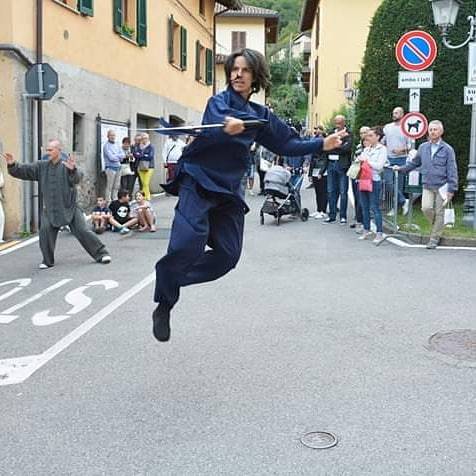
Anche nel taiji non riesco a stare con i piedi per Terra. #taiji #esibizione #esibizionista #garlate #festadellecorti #festadellecorti2019 #taichi #taichichuan #taijiquan #taiji4ever #jump #treccine #spada #taijijian #taijisword #pettinatura #capellinelnaso #sword #pelinelnaso #streetart #ccaawushu #ccaataiji #culturalchineseartacademy Esibizione di taiji a Garlate (presso Garlate) https://www.instagram.com/p/B2bmQynIe5H/?igshid=1uet1188nqbko
#taiji#esibizione#esibizionista#garlate#festadellecorti#festadellecorti2019#taichi#taichichuan#taijiquan#taiji4ever#jump#treccine#spada#taijijian#taijisword#pettinatura#capellinelnaso#sword#pelinelnaso#streetart#ccaawushu#ccaataiji#culturalchineseartacademy
0 notes
Photo
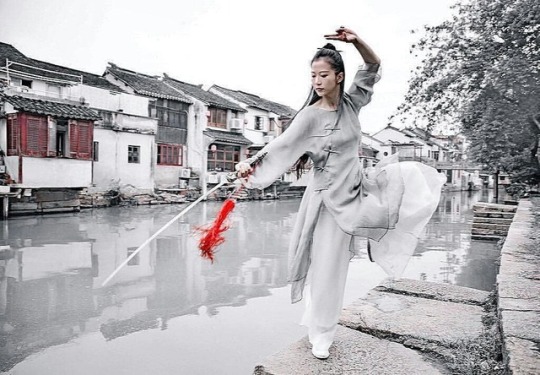
「太極劍·哪吒探海」Taichi sword “Nezha explores the sea” . . . . . . . . . . @kung.fu.world @taichi.space @chinatanglondon @gvmonthly @wukongphoto @sonyalpha @icelandair @ellechina @cntraveler @essentialtaichi @swordersfineart @insshanghai @thedailymileuk @nhk_online . . . #太極 #太极剑 #太極拳 #藝術 #武術 #功夫 #中國 #古鎮 #刺客聂隐娘 #静 #力 #神 #oldtown #taichi #art #kungfu #sword #kungguworld #martialarts #chinese #china #beauty #taiji #taijisword #performanceart #culture #meditation #assassinscreed #powergirl #innerpeace https://www.instagram.com/katana_sword_reviews/p/Bvp78l9Ftpi/?utm_source=ig_tumblr_share&igshid=1cu7nmshr2c69
#太極#太极剑#太極拳#藝術#武術#功夫#中國#古鎮#刺客聂隐娘#静#力#神#oldtown#taichi#art#kungfu#sword#kungguworld#martialarts#chinese#china#beauty#taiji#taijisword#performanceart#culture#meditation#assassinscreed#powergirl#innerpeace
17 notes
·
View notes
Video
lucid flows between life and death. the hunter can learn how to garden. #Repost @taichizhe with @get_repost ・・・ Share the basic movements of a Tai Chi knife. If you like, you can practice with me! #chenstyletaiji #chenstyletaijiquan #taijiquanchen #taijitsu #taichi #taichichuan #taichisword #taichimurakami #taiji #taijiquan #taijijian #chentaijiquan #taichizhe #taichizhe #meditation #wudangshan #wushu #wudang #taichi #taichung #taichichuan #taiji #taijiquan #taijijian #taijitsu #taichimaster #taichichuanyang #taichichuan #taichiquan #taichisword #chentaichi #taijitu #wudangtaiji #chentaijiquan #taijifit #chenstyletaiji #taijiquanchen #chenstyletaijiquan#taijidao #TaiChiknife #taichi_beauty #taijisword (at Los Angeles, California) https://www.instagram.com/p/BsWORlYg4Kr/?utm_source=ig_tumblr_share&igshid=10bcqnc13onv5
#repost#chenstyletaiji#chenstyletaijiquan#taijiquanchen#taijitsu#taichi#taichichuan#taichisword#taichimurakami#taiji#taijiquan#taijijian#chentaijiquan#taichizhe#meditation#wudangshan#wushu#wudang#taichung#taichimaster#taichichuanyang#taichiquan#chentaichi#taijitu#wudangtaiji#taijifit#taijidao#taichiknife#taichi_beauty#taijisword
0 notes
Photo
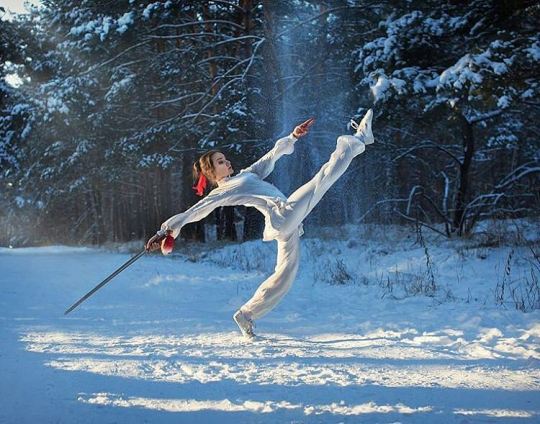
Darya Demchenko
Photo:Sergey Sukhovey Instagram
#taijisword#wushugirl#taichi#nature#photography#kungfu#snow#wushujian#wayofwushu#wushu#kungfugirl#winter
66 notes
·
View notes
Text
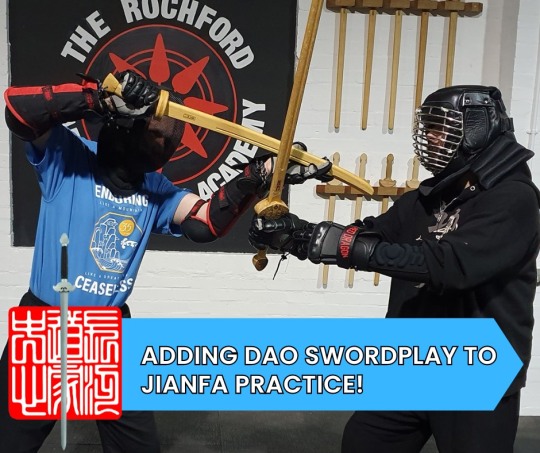
Merging Jianfa & Daofa in Your Swordplay:
Practitioners of Jianfa looking to explore the depths of Chinese swordsmanship, incorporating Daofa, the art of the saber, can add a more assertive, power orientated flavor to your swordplay.
This journey is not just a weapons switch up; it's about expanding your mindset, augmenting your skill set, while broadening your approach to swordsmanship.
In this guide, we'll navigate through the transition, focusing on practical techniques and insights to enhance your martial arts skills.
The Jian, with its straight, double-edged blade, epitomizes precision, agility, and adaptability, demanding a level of finesse and fine movement.
In contrast, the Dao, featuring heavier cuts, is a single-edged blade, representing power and efficiency in combat.
Uniting Daofa with Jianfa involves more than learning to handle a different sword, it means embracing a different approach in swordplay.
The Dao's point of balance is more forward than the Jian’s. This provides for more powerful cuts and thus a significant shift in technique. Daofa focuses not on the quick, wrist-led maneuvers that are the essence of Jianfa, instead focusing on powerful, elbow-driven techniques.
This style engages larger muscle groups for stronger and more impactful strikes, a key aspect in effectively wielding the Dao.
Starting with Pi Cut from Stirring Deflection
Begin your transformation with a drill common to both Jianfa and Daofa, the Pi cut from a stirring deflection. This provides a familiar base while introducing Dao's unique handling characteristics.
Chan involves a binding or wrapping movement, where the blade circles the body. It's a deflecting technique where the flat of the blade is used to deflect an incoming cut on one side of the body and then continues the motion to circle the blade around the torso, behind the back. This allows for a follow-up cut from the opposite side.
Deflecting with a Chan movement, the empty hand moves inside the blade, close to the chest, and can be employed to momentarily control the opponent’s sword arm as one advances forward. Training this technique introduces practitioners to the closer, more direct combat style found in Daofa. In contrast, Jianfa's prefers maintaining a distance that provides space to maneuver.
After gaining familiarity with the Pi and Hua cuts, it's insightful to progress to the distinctively heavier Kan cut. The Kan is and unique to saber systems, not being present in Jianfa.
Following this, the Duo cut would be the next logical cut to add. While the Duo cut is also present in Jianfa, it’s not made use of as frequently when wielding the straight sword.Training Daofa’s use of the Duo reminds us of why we are evolving our swordplay, merging the mindsets of Jianfa and Daofa, mixing more aggressive and assertive actions into our sword work.
In practice, although the timing of the Duo cut may appear similar to its Jianfa counterpart, it requires a considerably larger window of opportunity, reflecting the bolder and more direct approach of Daofa.
This exploration into the Duo cut provides practitioners with a new perspective on the rhythm shift from the more measured Jianfa to the dynamic and forceful Daofa.
The Pi cut can be likened to the power needed to trim a leaf off a tree, the Kan cut to chopping a thick branch, and the Duo cut to the robust action of felling an entire tree or splitting a log. This progression not only illustrates the escalating power inherent in Daofa techniques but also underscores the distinct tactical mindset required for this style of swordplay.
The Gua cut, though mechanically akin to the Liao cut in Jianfa, takes on a unique role in Daofa. It focuses an aggressive sweeping action to proactively capture the line, reflecting Daofa's assertive and power-oriented nature of Dao swordplay.
Incorporating shield work, especially with durable circular cost effective riot shields, provides insight into how the Dao would have been wielded on the battlefield. This practice not only enhances sword skills but also offers a better understanding of strategic defense and offense in historical combat contexts.
You can use a rattan Tengpai, but these are a lot more costly than a riot shield, which are far cheaper and will hold up to virtually anything you can throw at it during swordplay.
These individual cut drills can be combined into dynamic semi-fixed sparring routines, crucial for experiencing the reactive and adaptive nature of Daofa and preparing for unpredictable combat situations.
Merging Jianfa to Daofa offers an opportunity to evolve your understanding of Chinese swordsmanship, introducing new techniques and strategic thinking. It also adds tactical options to your swordplay, making you less predictable. This journey, embraced with dedication and an open mind, not only enhances your swordplay skills but also enriches your overall approach to swordsmanship. Enjoy the growth and mastery that come with learning the powerful art of the Daofa.
—----
All of the drills and cuts discussed in this guide can be found in the Daofa sections of the Academy of Chinese Swordsmanships Online Archives. Available to all members of the Daofa and Sword Scholars Study paths.
Visit www.chineseswordacademy.com for more details.
#chineseswordsmanship#jianfa#duanbing#chinesemartialarts#chineseswordplay#chineseswordfighting#scottmrodell#jianshu#daofa#scottrodell#daoistswordarts#chineseswordarts#swordfightingclasses#ukchineseswordfighting#taijijian#taijiswordfencing#taijisword#wudangsword#wudangjian#taijidao#taijisaber#swordfightingschool#kungfuweapons#swordfightingskills#chineseswordwork#swordtraining#劍法#刀法#chinesesword#yangjiamichuantaijijian
6 notes
·
View notes
Text

Reality Check…
#jianfa#chineseswordsmanship#jianshu#chineseswordfighting#chineseswordplay#scottmrodell#swordplay#duanbing#chinesemartialarts#chinesemartialart#taijisword#wudangsword#wudangjian#daoistswordarts#yangjiamichuantaijijian#taichisword#swordfightingclasses#swordfightingschool#swordclasses#chineseswordwork#chineseswordfencing#taijiswordfencing#fullcontact#swordfighting#swordfigther#swordfights#chineseswordarts#swordarts#historicalswordsmanship#chinesesword
5 notes
·
View notes
Text
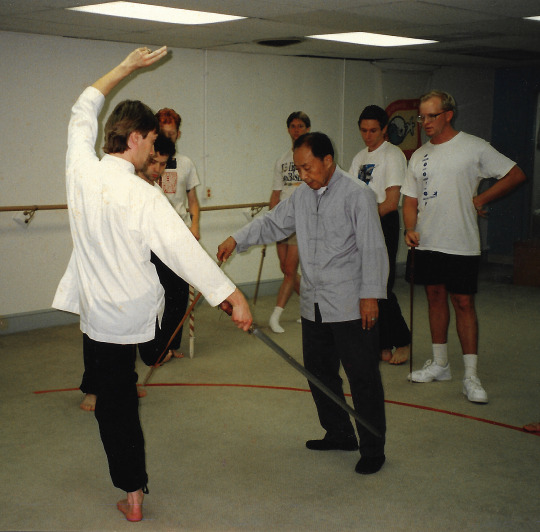
Wang Yen-nien schooling Scott M. Rodell on the finer points of the Yangjia Michuan Taiji Sword Form (楊家秘傳太極劍).
This Sword Form lies at the core of our Sword Work at the Academy of Chinese Swordsmanship.
We also draw upon the Ming period Two-Handed Dandao, the Four Roads Miaodao, the Yang Style Taiji Sword and Saber, and the WW2 Dadao.
#楊家秘傳太極劍#jianfa#chinesemartialarts#duanbing#chineseswordfighting#chineseswordsmanship#jianshu#scottmrodell#chineseswordplay#太極劍#swordclasses#scottrodell#wangyennien#chineseswordarts#chineseswordwork#ukchineseswordfighting#taijiswordfencing#taijisword#swordtraining#劍術#taijijian#chinesesword#chineseswordsman#yangstyletaichi#kungfuweapons#daoistsword#daoistswordsman#swordarts#historicalswordsmanship#swordfightingschool
3 notes
·
View notes
Text
Training is a Treasure.

#jianfa#chineseswordsmanship#chineseswordfighting#scottmrodell#chinesemartialarts#duanbing#chinesemartialart#chineseswordplay#jianshu#daoistswordsman#daoistswordarts#yangjiamichuantaijijian#taijisword#taichisword#wudangsword#wudangjian#taijijian#chinesemartials#chineseswordarts#swordarts#taijiswordfencing#chineseswordfencing#ukchineseswordfighting#swordplay#swordwork#swordworkout#chineseswordwork#scottrodell#swordfightingschool#swordfightingclasses
3 notes
·
View notes
Text

“In the midst of chaos, there is also opportunity”
INSTANT ACCESS. ANYWHERE. ANYTIME.
Sign up for our FREE 7 DAY TRIAL.
Find a study path that’s right for you..
#chineseswordsmanship#jianfa#chineseswordfighting#chineseswordplay#chinesemartialarts#scottmrodell#duanbing#jianshu#scottrodell#daoistswordarts#swordclasses#swordfightingschool#swordfighter#swordfightingskills#chineseswordarts#swordarts#taijijian#taijiswordfencing#taijisword#taichisword#chinesesword#chineseswordfencing#kungfuweapons#swordplay#yangjiamichuantaijijian#yangstylestaijiquan#yangstyletaichichuan#yangstyletaichi#ukchineseswordfighting#historicalswordsmanship
2 notes
·
View notes
Text
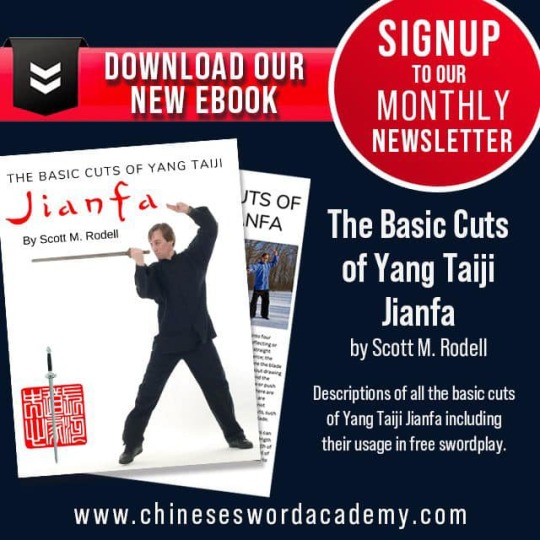
SIGNUP TO OUR MONTHLY NEWSLETTER
DOWNLOAD OUR NEW EBOOK HERE
https://www.chineseswordacademy.com/ebooksignup
The Basic Cuts of Yang Taiji Jianfa
by Scott M. Rodell
Descriptions of all the basic cuts of Yang Taiji Jianfa including their usage in free swordplay.
#chineseswordsmanship#jianfa#chineseswordfighting#chineseswordplay#scottmrodell#chinesemartialarts#duanbing#chinesemartialart#scottrodell#yangjiamichuantaijijian#taijiswordfencing#taijisword#taijijian#taichisword#yangstyle#yangstylestaijiquan#yangfamilytaijiquan#yangstyletaichichuan#chinesesword#chineseswordfencing#kungfuweapons#swordfighter#chineseswordwork#swordfightingskills#swordfightingschool#swordfightingclasses#swordclasses#swordclass#jianshu#daoistswordarts
2 notes
·
View notes
Text
FREE EBOOK COMING SOON
The Basic Cuts Of Yang Taiji Jianfa
By Scott M. Rodell
Available for free download Friday August 5.
Descriptions of all the basic cuts of Yang Taiji Jianfa including their usage in free swordplay.

Launching Friday!
#chineseswordsmanship#jianfa#chineseswordfighting#chineseswordplay#swordplay#scottmrodell#jianshu#duanbing#chinesemartialart#chinesemartialarts#scottrodell#taijijian#taijiswordfencing#taijisword#yangjiamichuantaijijian#yangshitaijijian#wudangsword#wudangjian#chineseswordwork#chinesesword#swordfightingclasses#swordfightingskills#swordclasses#chineseswordfencing#kungfuweapons#swordsmanship#daoistswordarts#daoistswordsman#chineseswordsman#chineseswordarts
2 notes
·
View notes
Text


A scroll titled Countries Figure (Kunigni Jinbutsukan) in the Kyoto National Museum depicts a Chinese Military Officer carrying a Jian. This work apparently dates to the early Ming period. What’s interesting about this image is that this military man is carrying his Jian in his left hand, rather than having it suspended from his belt. While this depiction of the sword carried in the hand rather than strapped to the belt is not new, it suggestions the idea that this depiction is not simply the standard artistic convention as the Japanese envoy who painted this was apparently recording what he saw.
Another element previously observed is that the Jian is grasped not close to the center of balance when it is sheathed, but close to the scabbard throat.
#chineseswordsmanship#jianfa#chineseswordfighting#chineseswordplay#jianshu#chinesemartialarts#duanbing#chinesemartialart#swordplay#chineseswordsman#chinesesword#taijiswordfencing#taijijian#taijisword#wudangsword#wudangjian#swordfighter#chineseswordwork#kungfuweapons#kungfu#mingdynasty#swordfightingskills
2 notes
·
View notes
Text
WANT TO LEARN CHINESE SWORDSMANSHIP?
INSTANT ACCESS. ANYWHERE. ANYTIME.
Sign up for our FREE 7 DAY TRIAL.
https://www.chineseswordacademy.com/membershipsandcourses
Find a study path that’s right for you.
Simply put, the Academy was born out of a desire to continue to move forward during these demanding times. Training at the Academy centers on developing practical, effective skills. To that end, Webinars concentrate on hand and footwork in the context of full contact swordplay tested cut combinations.
We don’t teach forms, we focus on tried and true application. Practitioners from a wide spectrums for traditions, Xingyiquan, Baimei, Wing Chun, Baguazhang, Taijiquan, Tanglangquan, and others, as well as non-Chinese traditions, train at the Academy. We look forward to training with you.
Founded in 1984, Great River Taoist Center is 35 years strong. Chinese Swordsmanship is not the latest fad for us, it is a three decade passion. Center director, Scott M. Rodell, is a well know leader in the rebirth of the art being the first practitioner to practice test cutting with Chinese swords since imperial times. Along side his years of experience in historical swordplay and training under acknowledged masters, Rodell has penned nine books on Chinese Martial Arts. These include several translations of classic sword manuals.
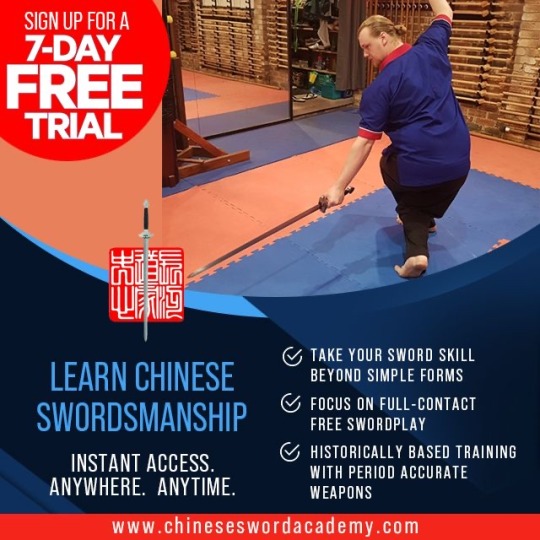
#jianfa#chineseswordsmanship#chineseswordfighting#jianshu#chineseswordplay#scottmrodell#duanbing#swordplay#chinesemartialart#chinesemartialarts#chineseswordwork#chineseswordsman#chinesesword#fullcontact#swordarts#taijiswordfencing#taijisword#taichisword#taijijian#yangjiamichuantaijijian#daofa#miaodao#chineselongsword#chineseswordfencing#daoistswordarts#daoistsword#wudangsword#wudangjian#kungfuweapons
5 notes
·
View notes
Photo
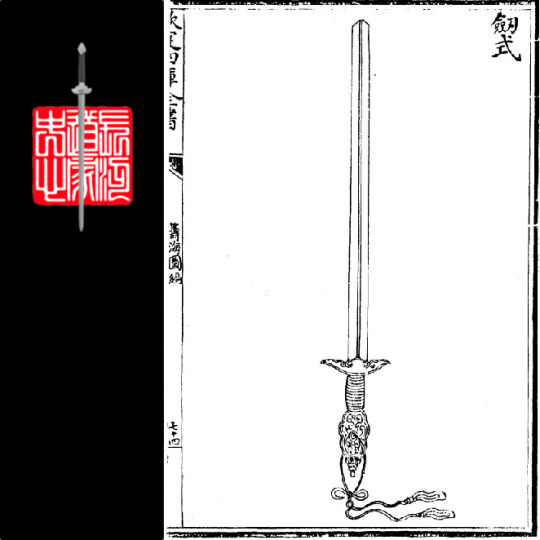
Ming Period Jian as Depicted in Sāncái Tú Huì, 三才圖會. Note the “V” shaped angular tip that was a common feature of Ming Jian.
#mingsword#mingdynasty#chineseswordsmanship#historicalswordsmanship#swordsmanship#chineseswordfighting#duanbing#swordfighting#chineseswordplay#swordplay#chineseswordwork#swordwork#daoistswordarts#chineseswordart#swordarts#swordart#daoistsword#daoistswordman#taijijian#taijisword#taichisword#wudangjian#wudangsword#chinesemartialarts#chinesemartialart#swordfightingschool#swordfightingskills#swordtraining#swordclasses#swordclass
14 notes
·
View notes